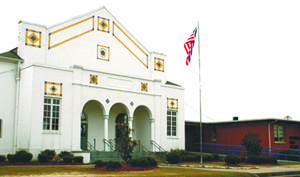Written by Blake Evans, CLA Graduate Assistant.
 On February 20 and 27, 2015, students at Notasulga High School pondered some of the most difficult, challenging, and influential decisions made in the past one-hundred years. Is the potential sacrifice worth the achievement of equality? Ninth and tenth grade students assumed the roles of citizens living in 1963 Birmingham, Alabama, to answer that very question. Using the “Separate and Unequal in 1963: How Can We Create a Fair Society?” issue guide created by the David Mathews Center for Civic Life and Alabama Public Television, students pondered the following three options to overcome the issue of racial inequality in historic Birmingham: 1. Use legislation to make a difference; 2. Develop relationships with others to create a movement; and 3. Take immediate action through boycotts and demonstrations.
On February 20 and 27, 2015, students at Notasulga High School pondered some of the most difficult, challenging, and influential decisions made in the past one-hundred years. Is the potential sacrifice worth the achievement of equality? Ninth and tenth grade students assumed the roles of citizens living in 1963 Birmingham, Alabama, to answer that very question. Using the “Separate and Unequal in 1963: How Can We Create a Fair Society?” issue guide created by the David Mathews Center for Civic Life and Alabama Public Television, students pondered the following three options to overcome the issue of racial inequality in historic Birmingham: 1. Use legislation to make a difference; 2. Develop relationships with others to create a movement; and 3. Take immediate action through boycotts and demonstrations.
Towards the beginning of each forum, students deliberated on the meaning of equality and the benefits of having it. They then watched clips of a video developed by Alabama Public Television for Project C. The video served as a reminder of life in 1960s Birmingham. Next, the students were challenged to go back to January 1, 1963. No longer were they high school students meeting for class. Instead, they became citizens of a town distraught with racial inequality. They were citizens meeting to discuss their options of achieving equality, a characteristic they unanimously agreed would improve society.
 The students deliberated by weighing their options and the consequences of their potential actions. They knew they needed to take a stand, but they also knew that every action would cause an opposing reaction. Many students considered the first option, taking legislative action, to be the best; however, others thought that option would require too much money to make a difference in the eyes of legislators. Some students thought that building relationships could be the best way to create change. They said this would mean spreading their message via fliers, word-of-mouth, and through local media outlets. However, they pointed out that the downside to that approach could possibly be violence, especially since it would require public action. Finally, many students thought the third approach was best, which was to demonstrate and promote boycotts and sit-ins. They recognized that this could have an economic impact and could hurt the pockets of those in power, thereby forcing lawmakers to push for change. They pointed out, though, that violence could come with this approach as well.
The students deliberated by weighing their options and the consequences of their potential actions. They knew they needed to take a stand, but they also knew that every action would cause an opposing reaction. Many students considered the first option, taking legislative action, to be the best; however, others thought that option would require too much money to make a difference in the eyes of legislators. Some students thought that building relationships could be the best way to create change. They said this would mean spreading their message via fliers, word-of-mouth, and through local media outlets. However, they pointed out that the downside to that approach could possibly be violence, especially since it would require public action. Finally, many students thought the third approach was best, which was to demonstrate and promote boycotts and sit-ins. They recognized that this could have an economic impact and could hurt the pockets of those in power, thereby forcing lawmakers to push for change. They pointed out, though, that violence could come with this approach as well.
With each consideration, students had to weigh trade-offs. Students do not usually weigh these kinds of consequences in terms of how it would have affected them as actual, boots-on-the-ground political activists. Through their deliberations, students gained a greater appreciation of the sacrifice that was made by many to achieve the society that we live in today. They realized that stepping into the shoes of others provides a different perspective than their own, and the ability to consider other opinions is essential to the significance of diversity and equality.
Special thanks to Coach Rogers at Notasulga High School for helping coordinate the forums!
